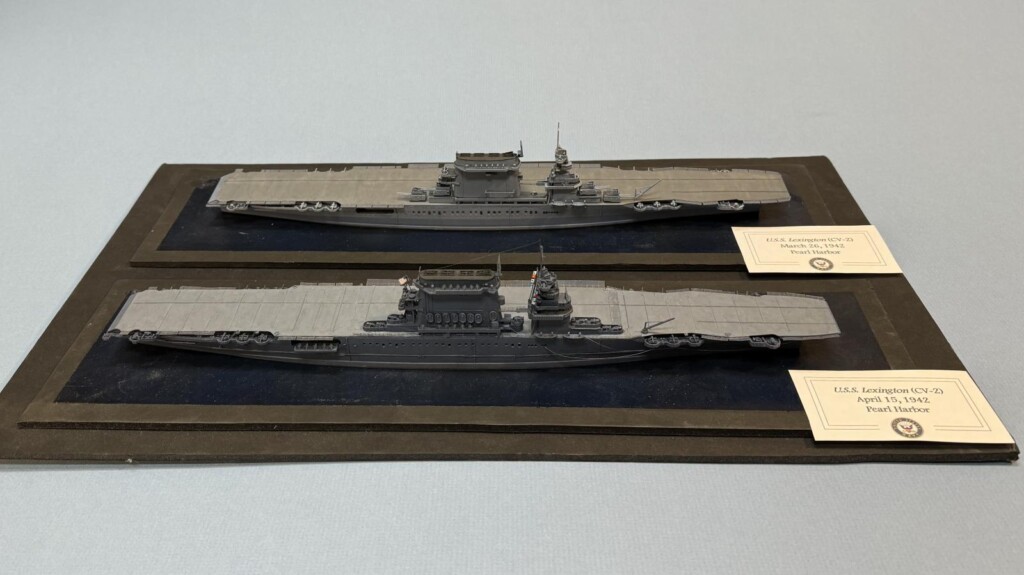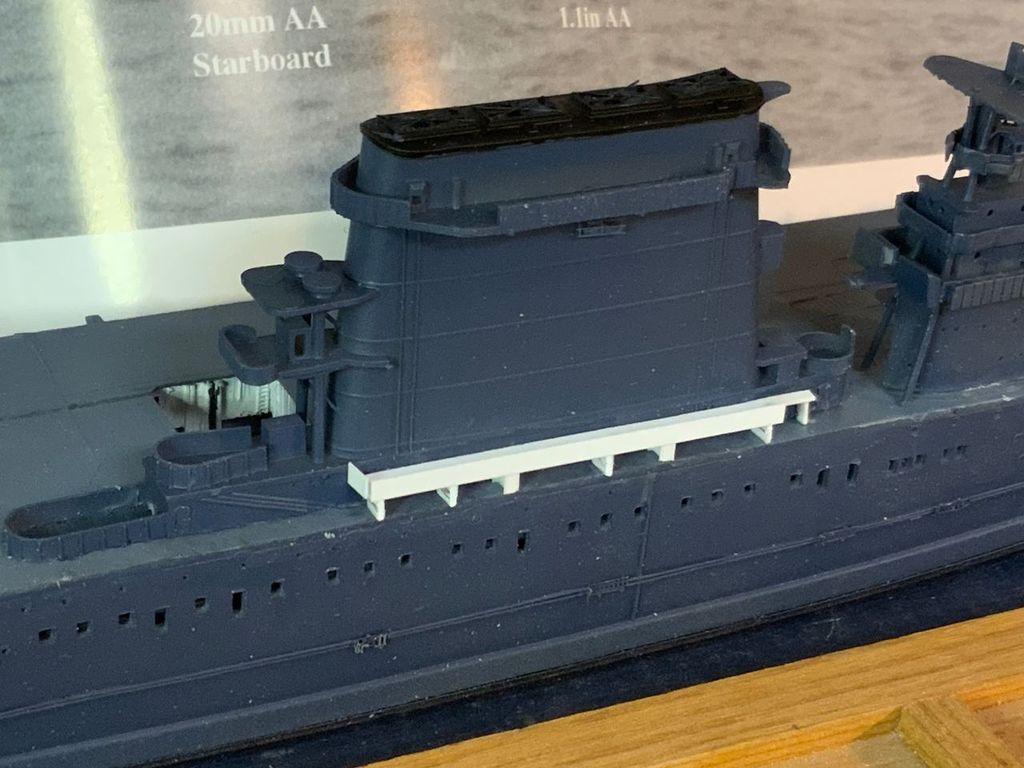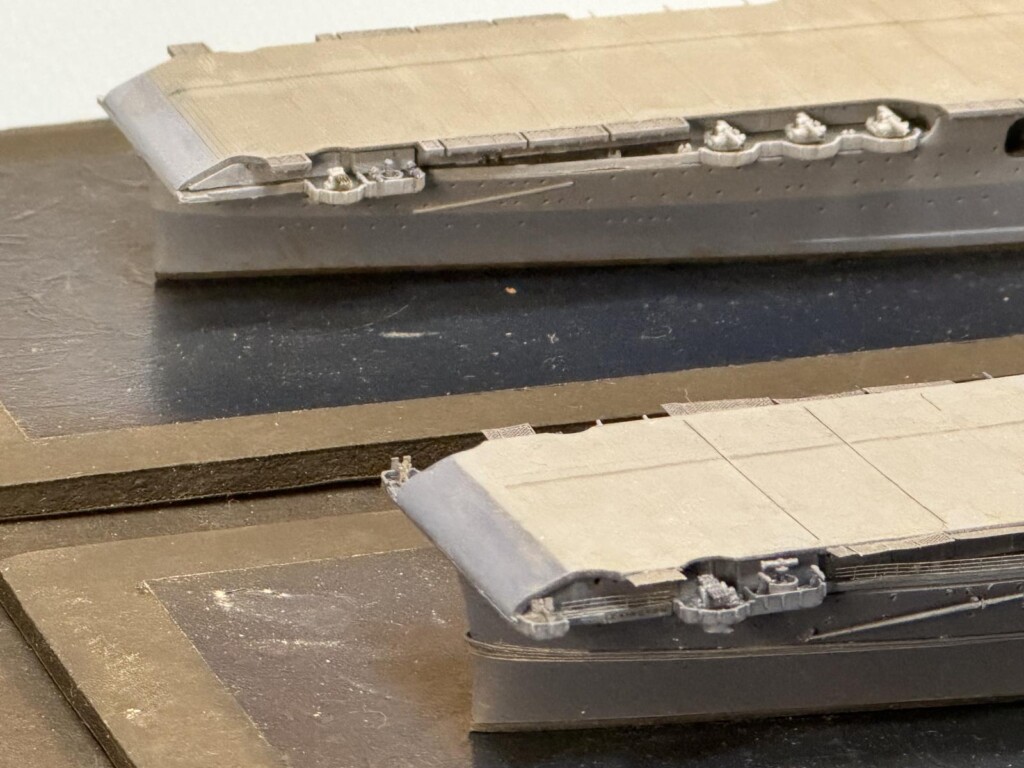The Last Refit – USS Lexington (CV-2) Before And After March/April 1942 Pearl Harbor Refit
This double build of 1/700 Trumpeter and Meng kits is intended to show how the aging U.S. carrier Lexington was refitted in two and a half weeks at Pearl Harbor in the spring of 1942 to improve her defensive capabilities. The carrier's March 25 appearance is shown by the Meng kit , and its April 15 appearance is shown by the Trumpeter kit with more extensive modification.
USS Lexington (CV-2)
Lexington was the Navy's first true aircraft carrier after the experimental Langley (CV-1). She and her sister Saratoga were converted from two battlecruisers cancelled due to post-WW I disarmament treaties, and were commissioned in 1927. They were huge as ships, which made them excellent as bases for large numbers of aircraft. But they were built at a time when aircraft were not perceived as ship-killing threats, and like other warships of the time, had minimal antiaircraft protection.
As war clouds loomed in the mid to late 1930s, Lexington in particular began to receive some upgrades to her defensive armament, including two hull sponsons forward for four .50 caliber weapons each. Shortly before war broke out those sponsons were revised to replace some of the .50 cals with heavier weapons - 1.1" quad mounts. Corresponding 1.1" quads and pairs of 50 cal. weapons were placed in corresponding positions on the aft end of the gallery decks flanking the flight deck, along with a fifth unit between the island and stack. But because the 1.1" mounts were not available, the installations initially featured 3" single mounts.
The ship's stack also began to sprout weapons, with half a dozen .50 cals on each side near the top of the stack, and another pair elsewhere on the island. Later, pairs of 50 cals were mounted on each of the carrier's four 8" twin turrets.
The 1.1" quads were eventually found and installed - possible during a yard period at Hunters Point in October 1941, which is when the ship painted over her badly weathering Measure 1 dark gray with Light Gray foremast camouflage with a sleek Measure 12 scheme consisting of Ocean Gray with a belt of Sea Blue at the waterline and masts in Haze Gray.
The March/April Refit
On March 26, 1942 Lexington steamed slowly into Pearl Harbor. She rounded Ford Island on the west side and pulled up to the Navy Yard where draftsmen and shipfitters had been waiting to harden her against the Japanese attacks she was expected to face in the coming weeks.
Lexington was in this essentially the same appearance she had had when ferrying aircraft to Midway when the Japanese struck Pearl Harbor on December 7,1941. Her visits to Pearl Harbor after this were short - to resupply before heading to the Coral Sea to operate with Yorktown (CV-5), newly transferred from the Atlantic Fleet. But she was recalled after the successful raids on Lae and Salamaua in March for a quick but essential refit to provide her with a significantly upgraded suite of antiaircraft weapons.
The Navy had been preparing for a refit of the ship, primarily to replace its four large 8" twin turrets - which were useless in antiaircraft defense - with four of the new 5" .38 caliber dual purpose turrets as were being fitted on Saratoga back at Bremerton, as well as add to her lighter antiaircraft battery.
The refit actually consisted of several changes to the ship.
Removal of 8" turrets / installation of 1.1" quads.
The centerpiece of the installation was to remove the four obsolete cruiser-style turrets with multiple 1.1" quad mounts. The extant plans showed a different arrangement from that eventually used, which consisted of a two-for-one replacement of turrets 1, 2 and 4, with only a single mount replacing turret #3.
New 20mm galleries
The .50 caliber weapon was being phased out in favor of the 20mm mount, but a complete upgrade of the AA suit was not possible. Instead, the former boat stowage outboard of the stack was extended, the last set of davits removed, and the new space filled with six 20mm mounts with associated clipping rooms.
Further down three of the five former boat pockets - two on the port side and one on the starboard, received galleries with 20mm mounts.
Finally, the aft corners of the gallery deck port and starboard had single 20mm mounts added.
The net effect of the refit was to increase the ship's AA armament from 20 1.1" barrels and 28 .50 caliber barrels to 48 1.1" barrels, 20 20mm guns, and 20 .50 caliber guns. The increase was not merely numerical 88 guns up from 48 - but exponential in terms of the carrier's AA "broadside" both in terms how much fire it could put up, and how far out that fire was effective. In practical terms, it approximately doubled the weight of steel that an attacking aircraft would face.
Admiral Fitch's Flag Bridge Extension
As originally built, the Lexingtons did not have a flag plot in the island. In the mid-1930s a small room was adding on the roof of the navigation bridge. When the Saratoga was refitted in the fall of 1941, the flag plot was extended forward and the existing range finder relocated to the roof the new flag plot, allowing construction of an enclosed flag bridge atop the captain's bridge.
Coincidentally, the admiral commanding the Saratoga during its refit, RADM Aubrey Fitch, became the Lexington's flag officer on April 3, 1942 - during its refit.
Lexington received a similar extended flag plot and enclosed flag bridge, with the plans explicitly noting that the rearrangement was to be "similar to Saratoga".
Mk. 3 radar
The Lexington also received an additional radar during the refit - a small Mk. 3 fire control unit was added to the roof of the forward 8" gun director.
A photo of the wreck taken in 2018 clearly shows the base for the radar on the roof of the forward 8" gun director.
Camouflage
The fall of 1941 was a period of transition and experimentation for naval ship camouflage in the Pacific, but by the spring of 1942 it was generally observed that a ship painted blue was better concealed than one painted dark gray (Measure 1) or in horizontal pattern in lighter blue shades (Measure 12). Thus Lexington was repainted in the Measure 11 overall Sea Blue (5-S) scheme. However, since Sea Blue was believed to be too light, a darker version of the same paint referred to as Navy Blue (5-N) was substituted.
With as fresh coat of camouflage paint, and dozens of new AA mounts, Lexington sortied from Pearl Harbor on April 15 and set course for the Coral Sea, where she would be sunk on 8 May 1942 during the Battle of the Coral Sea.
The April 15 Lexington
For the post-refit version of Lexington I used the Trumpeter kit, which portrays her in May 1942. The kit is generally good, but has a few shortcomings.
Principally, the flight decks lacks any detail at all. It does not have arresting gear aft or forward, and even deletes the longitudinal deck drains that are present on Trumpeter's 1936 Saratoga. It is also missing the degaussing cables on the hull, and the roof of the forward 8" gun director is flat, when it should be sloping. The former boat stowage/20mm AA gallery at the base of the stack is - correctly - extended slightly beyond the ship's hull - photos during the refit showed it being extended outwards - but it is level with the first level of the stack when it should be 2 1/2 scale feet below. The Mk. 4 radar on the forward 8" gun director is not represented and the 20mm guns are way overscale.
The splinter shielding for the added 1.1" quads is also incorrect as it is squared off, not rounded, but this error is excusable since no photos or plans showed what was actually installed in a way that revealed this. Only photos of the wreck taken in 2018 showed the rounded shielding.
I made several changes to the kit using aftermarket products and scratchbuilding.
Degaussing Cables
I scratchbuilt the degaussing cables using .010 rod plastic
Photoetch
I used the GMM sheet for Lexington, which meant cutting off the kit flight deck netting. I did not use a lot of the smaller pieces, including the arresting gear sheaves, which were just too small for me. Using the Model Monkey island and stack meant using a lot of the watertight doors. I also added railings as shown.
20mm mounts
The kit mounts are substantially overscale, so rather than trim them and add PE shields I use a couple of packages of Blue Ridge 3D prints mounts. I mistakenly thought that the gun galleries at the top of the stack were upgraded from .50 caliber to 20mm so the mounts in those galleries are not accurate - they should be .50 cals.
Island & Stack
I replaced the kit parts with Model Monkey versions, which included the correctly shaped forward director roof and 1.1" splinter shielding. I added a GMM CXAM radar and Mk. 4 radar, as well as a gaff for the national ensign.
Stack 20mm gallery
The Model Monkey stack didn't have the boat stowage/20mm gallery level, so I added one with sheet plastic, placing it about 2 1/2 scale feet below the first superstructure level, and including clipping rooms where the Pearl Harbor plans showed - as confirmed by the famous May 8 photo of the ship.
Flight Deck elevator
A major flaw in the kit as shown in this photo of my 2017 build and the partially complete 2024 build is that the "down" position for the elevators only goes down one deck, not the actual 3 1/2 to the hangar deck.
I scratchbuilt the middle of the Lexington's hangar deck with the sides of the hangar and some scattered equipment and aircraft so I could lower the elevator all the way.
Paravane Cable
Underway photos of the Lexington in 1942 show large hanging cables forward on the starboard side. These appear to be paravane cables, as well as a line to the bow of the first ship's boat.
Finally, I added a nameplate on the starboard side of the stern and the Starfighter ship name decal. The real ship's was painted hull color, but the black decal is only a slight alteration to call out the location of the nameplate located in 2018.
The model replaces a 2017 build of the same kit (at rear)
It is my fifth wartime Lexington in 1/700, following 1976 and 1989 builds of the Fujimi kit.
The March 26 Lexington
For the March 26 version of CV-2 I chose the Meng kit, which portrays the ship after its flight deck was widened forward in 1937, but before the 8" turrets were removed. With the included 1.1" quads it is accurate - as far as it goes - for the appearance of the Lexington from an undetermined point in time after its October 1941 refit (whenever the 3" temporary mounts were replaced with 1.1" ones) until the March/April refit with one exception. It contains the 20mm mounts at the aft corners of the flight deck, so they were snipped off.
The only other changes to the kit were fairly minor. The foremast, which is significantly too long, was shortened, pairs of .50 caliber mounts and a piece of rod representing gun director were added to the gun galleries at the corners of the flight deck. The CXAM radar was not mounted correctly, so I added the correct base. I also added the walkway between the island and stack, two more rangefinders / directors
From at least the fall of 1941 the Lexington's 8" turrets were topped with railed platforms for two .50 cal AA guns. The railings were covered with canvas, but while the aft mounts were completely enclosed, the bow mounts only had the side and a short section of the sides covered with canvas.
Although the Lexington had landed most of its boats by March of 1942, it still had a single set of boat davits at the base of the stack, and the two whaleboats outboard of the island, neither of which is in the kit. I added replacements using the Skywave USN parts set.
Paints were ScaleColors Navy Blue, Ocean Gray, Sea Blue and Haze Gray. I used Testors enamel weather deck blue for decks and walkways.
























That's a lot of great work on these models, @mcsmith1964
Very nice result on this comparison build, Michael @mcsmith1964
Thanks for sharing the differences overview with us.
Wonderful work, Michael, and a lot of really good information in this writeup. Im glad to see MM is making the rounded gun tubs, as i remember that being a significang find from the dive that brought some insight to modellers and naval historians alike.
Its really cool to see the historical changes modeled, but among all else, thank you for taking to time to share this.
Now you ought to scratch build an as [would have been] built CC battlecruiser to put next to your fine Lexington builds, you know, to tell the whole story. 😉
I'm doing a 1936 Saratoga at some point, but doubt I'll go "quite" that far back! The elevator in the down position was rehearsal for that build, where I'll do both down. The forward elevator is a lot more of a challenge - the measurements have to be precise because the hangar walls track the elevator opening on three sides. So unless you build the entire hangar on the underside of the flight deck, the height of the hangar walls must precisely match the underside of the kit flight deck. But with that mahogany and chrome yellow deck sitting on white hangar walls - it will look so cool.
Wonderful work after thorough research, Michael!
Fantastic modelling topped off with a wonderful knowledge of the vessels that have been modeled. 👍
Excellent research and work. This is some good model work.
Excellent work on this, Michael.